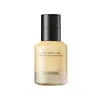What's inside
What's inside
 Key Ingredients
Key Ingredients

 Benefits
Benefits

 Concerns
Concerns

 Ingredients Side-by-side
Ingredients Side-by-side

Water
Skin ConditioningDipropylene Glycol
HumectantAlcohol Denat.
AntimicrobialNiacinamide
SmoothingBetaine
HumectantGlycerin
Humectant1,2-Hexanediol
Skin ConditioningPolyglyceryl-10 Stearate
Skin ConditioningGlycereth-26
HumectantPolyurethane-15
Propanediol
SolventCetearyl Alcohol
EmollientTromethamine
BufferingCarbomer
Emulsion StabilisingHydroxyethylcellulose
Emulsion StabilisingCeramide NP
Skin ConditioningAcrylates/C10-30 Alkyl Acrylate Crosspolymer
Emulsion StabilisingTriethylhexanoin
MaskingButylene Glycol
HumectantAdenosine
Skin ConditioningLactobacillus
Skin ConditioningSqualane
EmollientSaccharomyces/Potato Extract Ferment Filtrate
HumectantSaccharomyces/Coix Lacryma-Jobi Ma-Yuen Seed Ferment Filtrate
Skin ConditioningPhospholipids
Skin ConditioningLactobacillus/Soybean Ferment Extract
Skin ConditioningLactobacillus/Rice Ferment
Skin ConditioningHydrogenated Polydecene
EmollientDisodium EDTA
Calcium Titanium Borosilicate
AbrasiveCholesterol
EmollientPhytosphingosine
Skin ConditioningHydrogenated Lecithin
EmulsifyingTheobroma Cacao Extract
Skin ConditioningAquilaria Agallocha Wood Extract
Skin ConditioningGardenia Florida Flower Extract
Skin ConditioningTin Oxide
AbrasiveIron Oxides
CI 77491
Cosmetic ColorantCI 19140
Cosmetic ColorantDextrin
AbsorbentCI 77891
Cosmetic ColorantParfum
MaskingLimonene
PerfumingCitronellol
PerfumingGeraniol
PerfumingLinalool
PerfumingWater, Dipropylene Glycol, Alcohol Denat., Niacinamide, Betaine, Glycerin, 1,2-Hexanediol, Polyglyceryl-10 Stearate, Glycereth-26, Polyurethane-15, Propanediol, Cetearyl Alcohol, Tromethamine, Carbomer, Hydroxyethylcellulose, Ceramide NP, Acrylates/C10-30 Alkyl Acrylate Crosspolymer, Triethylhexanoin, Butylene Glycol, Adenosine, Lactobacillus, Squalane, Saccharomyces/Potato Extract Ferment Filtrate, Saccharomyces/Coix Lacryma-Jobi Ma-Yuen Seed Ferment Filtrate, Phospholipids, Lactobacillus/Soybean Ferment Extract, Lactobacillus/Rice Ferment, Hydrogenated Polydecene, Disodium EDTA, Calcium Titanium Borosilicate, Cholesterol, Phytosphingosine, Hydrogenated Lecithin, Theobroma Cacao Extract, Aquilaria Agallocha Wood Extract, Gardenia Florida Flower Extract, Tin Oxide, Iron Oxides, CI 77491, CI 19140, Dextrin, CI 77891, Parfum, Limonene, Citronellol, Geraniol, Linalool
Water
Skin ConditioningButylene Glycol
HumectantDimethicone
EmollientMethylpropanediol
SolventPhenyl Trimethicone
Skin ConditioningCyclopentasiloxane
EmollientMethyl Trimethicone
Skin ConditioningMagnesium Sulfate
Pentylene Glycol
Skin ConditioningSodium Hyaluronate
HumectantTitanium Dioxide
Cosmetic ColorantC12-15 Alkyl Benzoate
AntimicrobialGlyceryl Caprylate
EmollientAluminum Hydroxide
EmollientTrimethoxycaprylylsilane
SmoothingPentaerythrityl Tetra-Di-T-Butyl Hydroxyhydrocinnamate
AntioxidantCetyl PEG/PPG-10/1 Dimethicone
EmulsifyingDimethicone/PEG-10/15 Crosspolymer
Parfum
MaskingEthylhexylglycerin
Skin ConditioningWater, Butylene Glycol, Dimethicone, Methylpropanediol, Phenyl Trimethicone, Cyclopentasiloxane, Methyl Trimethicone, Magnesium Sulfate, Pentylene Glycol, Sodium Hyaluronate, Titanium Dioxide, C12-15 Alkyl Benzoate, Glyceryl Caprylate, Aluminum Hydroxide, Trimethoxycaprylylsilane, Pentaerythrityl Tetra-Di-T-Butyl Hydroxyhydrocinnamate, Cetyl PEG/PPG-10/1 Dimethicone, Dimethicone/PEG-10/15 Crosspolymer, Parfum, Ethylhexylglycerin
Ingredients Explained
These ingredients are found in both products.
Ingredients higher up in an ingredient list are typically present in a larger amount.
Butylene Glycol (or BG) is used within cosmetic products for a few different reasons:
Overall, Butylene Glycol is a safe and well-rounded ingredient that works well with other ingredients.
Though this ingredient works well with most skin types, some people with sensitive skin may experience a reaction such as allergic rashes, closed comedones, or itchiness.
Learn more about Butylene GlycolParfum is a catch-all term for an ingredient or more that is used to give a scent to products.
Also called "fragrance", this ingredient can be a blend of hundreds of chemicals or plant oils. This means every product with "fragrance" or "parfum" in the ingredients list is a different mixture.
For instance, Habanolide is a proprietary trade name for a specific aroma chemical. When used as a fragrance ingredient in cosmetics, most aroma chemicals fall under the broad labeling category of “FRAGRANCE” or “PARFUM” according to EU and US regulations.
The term 'parfum' or 'fragrance' is not regulated in many countries. In many cases, it is up to the brand to define this term.
For instance, many brands choose to label themselves as "fragrance-free" because they are not using synthetic fragrances. However, their products may still contain ingredients such as essential oils that are considered a fragrance by INCI standards.
One example is Calendula flower extract. Calendula is an essential oil that still imparts a scent or 'fragrance'.
Depending on the blend, the ingredients in the mixture can cause allergies and sensitivities on the skin. Some ingredients that are known EU allergens include linalool and citronellol.
Parfum can also be used to mask or cover an unpleasant scent.
The bottom line is: not all fragrances/parfum/ingredients are created equally. If you are worried about fragrances, we recommend taking a closer look at an ingredient. And of course, we always recommend speaking with a professional.
Learn more about ParfumWater. It's the most common cosmetic ingredient of all. You'll usually see it at the top of ingredient lists, meaning that it makes up the largest part of the product.
So why is it so popular? Water most often acts as a solvent - this means that it helps dissolve other ingredients into the formulation.
You'll also recognize water as that liquid we all need to stay alive. If you see this, drink a glass of water. Stay hydrated!
Learn more about Water